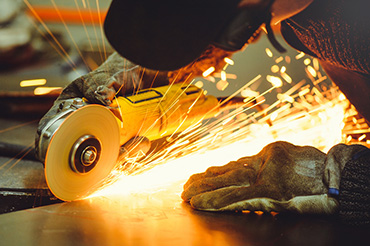TWS is a Great Training Option for Everyone
Learn more about how we can prepare you to advance your career.
As you’ll likely learn in your welding classes, fusing metals is just one small part of the job of the welder.
Preparing metals prior to applying heat to them and then cleaning them up afterwards are also important steps to ensuring quality work that keeps employers and customer happy. When it comes to prep and finishing practices, an angle grinder can be a welder’s best friend.[1]
How Does an Angle Grinder Work?
Angle grinders are welding tools commonly found in metal fabrication and other types of metalworking shops. They are handheld power tools with consumable stone discs or blades attached them.[2]
These discs or blades spin at high speeds to grind, polish or cut metals. Several disc sizes and amperages are available.[3] Larger discs and higher amperage are typically good for industrial projects like beveling thick-walled pipe.[4]
Have You Considered a Career in the Skilled Trades?
Fill out the form to recieve a no obligation info packet.
What Is an Angle Grinder Used For?
The angle grinder is an essential piece of welding equipment because of their diverse range of application. Let’s dive into a few of the most popular ways that welders use this tool for miraculous results.
Cutting Metal
With the appropriate cutting disc, you can use an angle grinder to cut thin metals. Metal cutoff wheels, however, can be used to cut rusted bolts, iron fencing or rebar because they employ an aluminum oxide as an abrasive.[5]
Preparing Metal
Cleaning base metals prior to welding them helps to prevent defects like porosity and cracking, especially for MIG and TIG welding because they don’t work well with slag.
While a wire brush can clean off paint, rust and mill scale on a base metal, an angle grinder may be a quicker option. Angle grinders with sanding discs can also perform much in the same way sand paper does for gritty metals but usually much faster.[6] Grinding discs would most likely be used for such tasks.[7]
Cleaning up and Finishing Welds
SMAW can be a messy process that leaves a lot of slag leftover, but an angle grinder is an effective way of removing it. The angle grinder also grinds down weld beads when performing root and fill passes in pipe welding.[8]
Flap discs can also be used to smooth or polish metal before powder coating or painting it.[9]
What Are Some Best Practices for Working With Angle Grinders?

Angle grinders can help ensure a welding job goes well, but things can still go wrong when using them. If you follow these practices when using the tool, you’ll have a much higher rate of success.
Match Grinding Disc RPM to Tool RPM
The maximum revolutions per minute (RPM) a grinding disc can go is usually listed on its blotter paper. Check the RPM of the grinding tool before placing a disc on it. If the machine has a higher RPM and the disc turns too quickly, it might explode.
Check for Cracks
Test grinding discs for cracks before placing them on the tool. Envision that an “X” is drawn over the disc, and tap each side where each arm of the letter would be. A sharp ring is a sign that the disc is in good working condition, but a dull sound suggests the stone could be cracked and shouldn’t be used.
Balance the Grinding Disc
Keeping a grinding disc trued and balanced ensures the disc stays flat on its face and sharp, which is necessary to produce the best results. Use a redressing tool to balance the disc once it’s been placed on the tool.
Use the Correct Metal
Different grinding discs are applied ferrous and nonferrous metals. Using a nonferrous disc on a ferrous metal will prematurely wear it down. Grinding a nonferrous metal with a ferrous disc can clog the disc with the metal, having the effect of glazing it. Frictional heat created during the grinding process can result in the glazed disc exploding.
Don’t Use Too Small of Discs
When grinding discs wear down to the size of a paper blotter, they shouldn’t be used.
Never Wear Gloves
Aren’t welding gloves important? Yes, but in the case of angle grinders, they can be a liability. Gloves can get caught in grinding discs, bringing the whole hand along with them. The point is, never wear gloves when using an angle grinder.
Direct Sparks Downward
Sparks might be awesome to look at, but they’re a lot less awesome when they’re flying in the direction of your eyes. Sparks should always be directed downward and away from people and equipment.[10]
Angle Grinders Are Useful Welding Tools
Angle grinders are great: They remove rust, smooth welds, grind grooves and cut metal. Understanding the variety of types and sizes of discs, the range of amperages and the proper procedures when using them make them all the better. Always know your tools to be the best welder you can be.
Learn more about safe practices for welders to be a better welder.
[1] https://www.bakersgas.com/weldmyworld/2012/12/28/how-to-use-an-angle-grinder/
[2] Title: Welding Principles and Applications; Author: Larry Jeffus; Delmar Cengage Learning; Seventh Edition; Textbook page 44
[3] https://lifehacker.com/tool-school-cut-grind-and-polish-with-the-versatile-1704087196
[4] http://www.weldersuniverse.com/cutting_grinding.html
[5] https://lifehacker.com/tool-school-cut-grind-and-polish-with-the-versatile-1704087196
[6] https://www.bakersgas.com/weldmyworld/2012/12/28/how-to-use-an-angle-grinder/
[7] http://www.weldersuniverse.com/cutting_grinding.html
[8] https://www.bakersgas.com/weldmyworld/2012/12/28/how-to-use-an-angle-grinder/
[9] http://www.weldersuniverse.com/cutting_grinding.html
[10] Title: Welding Principles and Applications; Author: Larry Jeffus; Delmar Cengage Learning; Seventh Edition; Textbook page 44
This blog has been labeled as archived as it may no longer contain the most up-to-date data. For a list of all current blog posts, please visit our blog homepage at https://www.tws.edu/blog/







